• Non-Stick
How Do You Strip And Reseason A Carbon Steel Pan + Better Ways To Fix It

Reviewed by Trinity Anderson
Last Updated February 2024
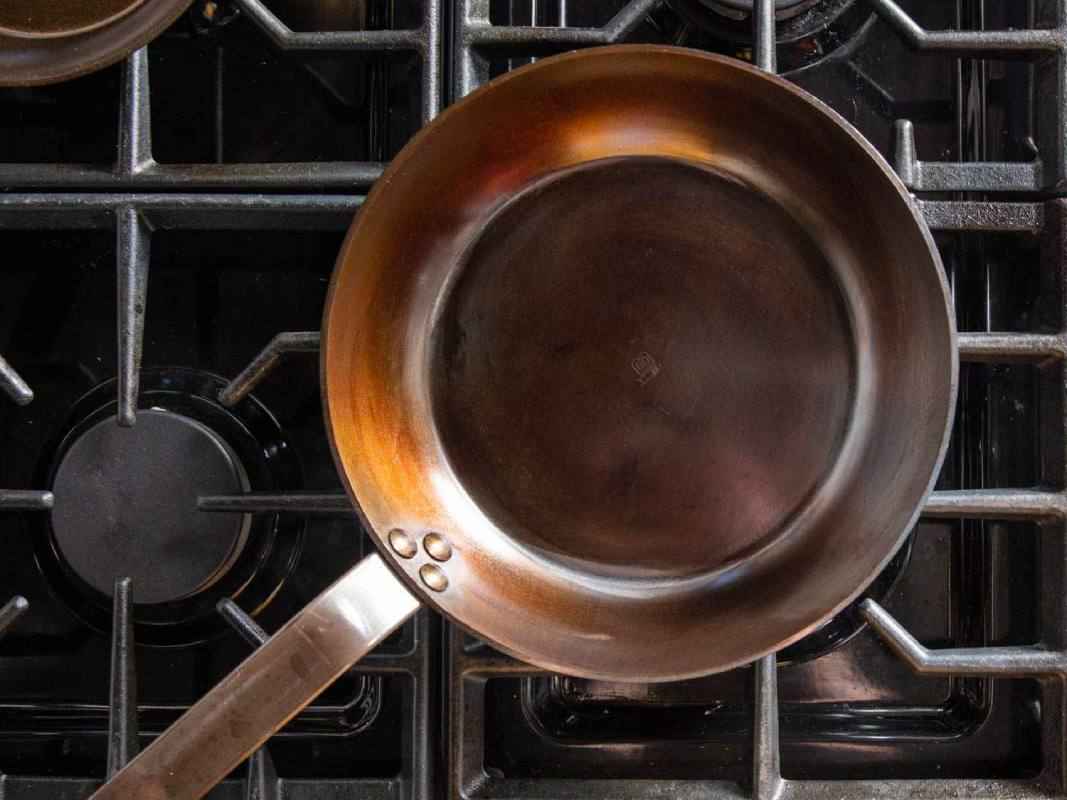
Seasoning plays a vital role in the daily use of a carbon steel pan. Over time, layers of seasoning naturally develop as you cook with the pan. However, there may come a time when you need to enhance the seasoning of a pan that appears dry.
Nevertheless, completely stripping a carbon steel pan, also known as "nuking" it, is rarely necessary. Issues such as flaking seasoning, carbon buildup, and sticky spots can all be resolved without removing the layers of blackened polymerized oil that have formed on your pan. Trust me, removing that stuff is quite challenging.
As I've gained more experience working with carbon steel pans in my kitchen, I have discovered numerous techniques for restoring seasoning. In this discussion, we will explore how to strip and re-season a carbon steel pan, determine when it is necessary, and discover less drastic methods to fix uneven seasoning.
How To Strip and Reseason a Carbon Steel Pan?
To effectively strip and re-season a carbon steel pan, follow these steps:
1. Begin by scrubbing the pan thoroughly to eliminate any carbon buildup.
2. Next, fill the pan with a solution consisting of 50% vinegar and water.
3. Bring the pan to a boil and let it simmer for approximately 20 minutes.
4. Allow the pan to cool down and sit for a few hours.
5. Once cooled, use steel wool to scrub off the existing seasoning.
6. Finally, apply a small amount of oil to the pan and heat it to properly season it.
It's important to note that this method solely focuses on removing seasoning from the inside of the pan. However, there are alternative techniques available to remove buildup from the outside of the pan as well.
I’ll go into details on all of these in a bit.
When Do You Need to “Nuke” or Strip Your Carbon Steel Pan?
The three main reasons why you may choose to strip a carbon steel pan include severe rust, excessive carbon buildup, or a flaking first layer of seasoning.
Reason #1: Rust
If the seasoning on a carbon steel pan wears thin, rust can occur. To remove small rust spots, a simple scrub with oil and salt can do the trick. However, if the pan has been neglected and rusted for a long time, the rust may have caused significant damage to the iron. In such cases, starting from scratch by stripping the pan may be the best option.
Reason #2: Excessive Carbon Buildup
In my personal experience, I once attempted to caramelize sugar in a carbon steel pan, but it ended up bonding to the seasoning, leaving behind black grit. Although I managed to remove some of it through boiling water and scrubbing, the damage to the seasoning was already done. At that point, I decided it was best to start over and strip the pan.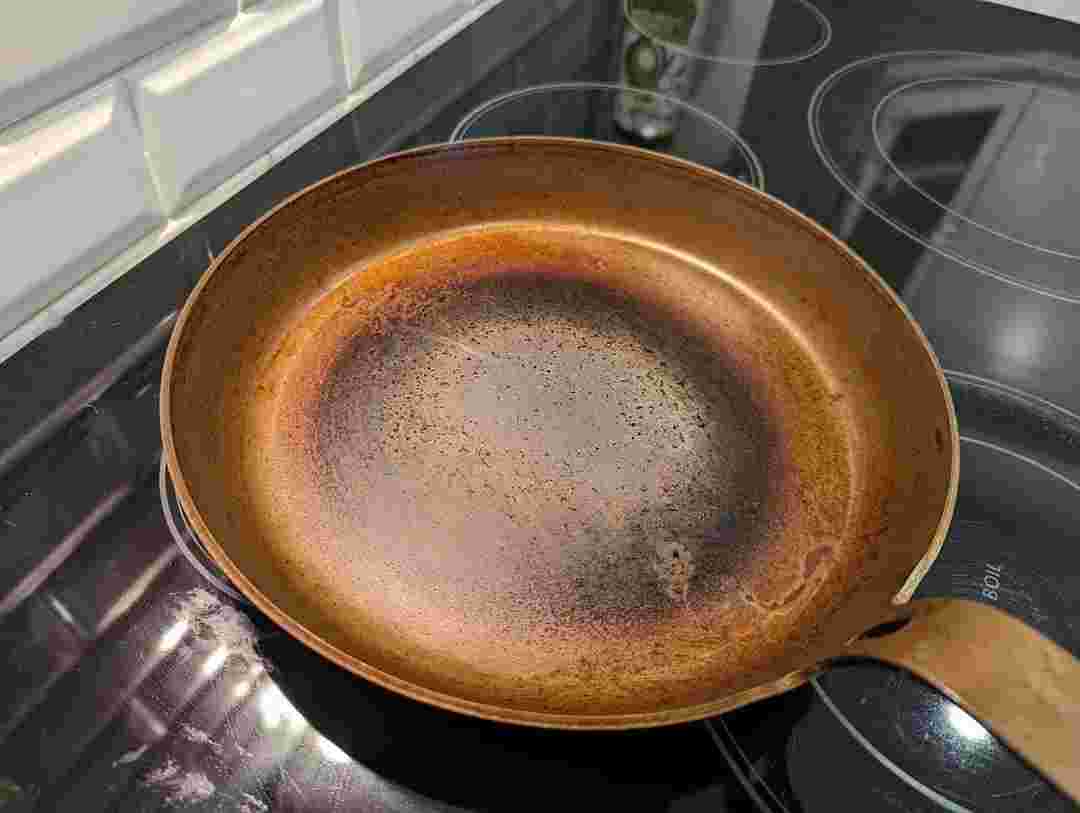
Reason #3: Poor Initial Seasoning
Not all cases of flaking seasoning require stripping the pan. However, certain oils, like flaxseed oil, can produce brittle coats of seasoning that are more prone to flaking. If the first layer of seasoning on your pan is brittle and flaking, it might be worth considering stripping it and trying a different oil for a more durable seasoning.
That's exactly what happened with my friend's Misen pan, which I volunteered to strip and re-season. The initial layer of seasoning was flaking, and there was a significant amount of carbon buildup. In this tutorial, you'll find the photos documenting the process of stripping and reseasoning her Misen fry pan.
What You Will Need to Strip and Re-Season Carbon Steel
- Coarse salt
- White vinegar
- Oil with a high smoke point (grapeseed, canola, refined avocado)
- Heavy-duty scrubbing pads or scours
- Paper towels or cotton rags
- Large basin or sink
- Oven or stove
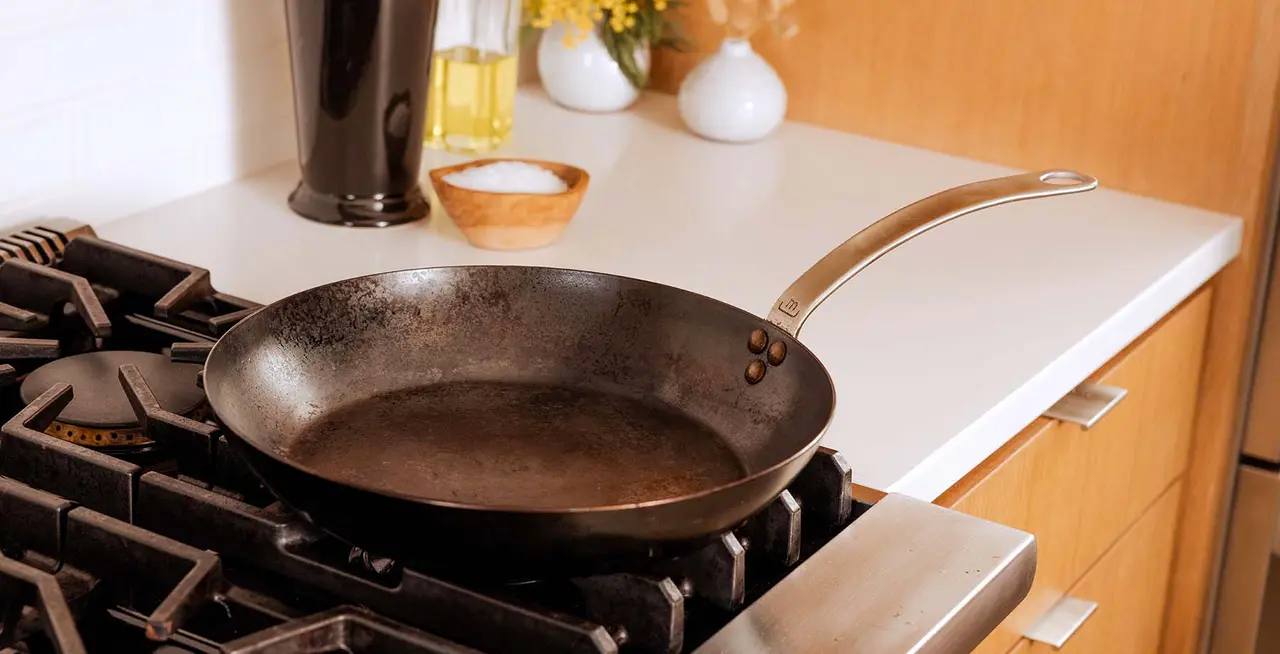
How to Strip and Re-Season a Carbon Steel Pan Step-By-Step
1. Clean the Pan
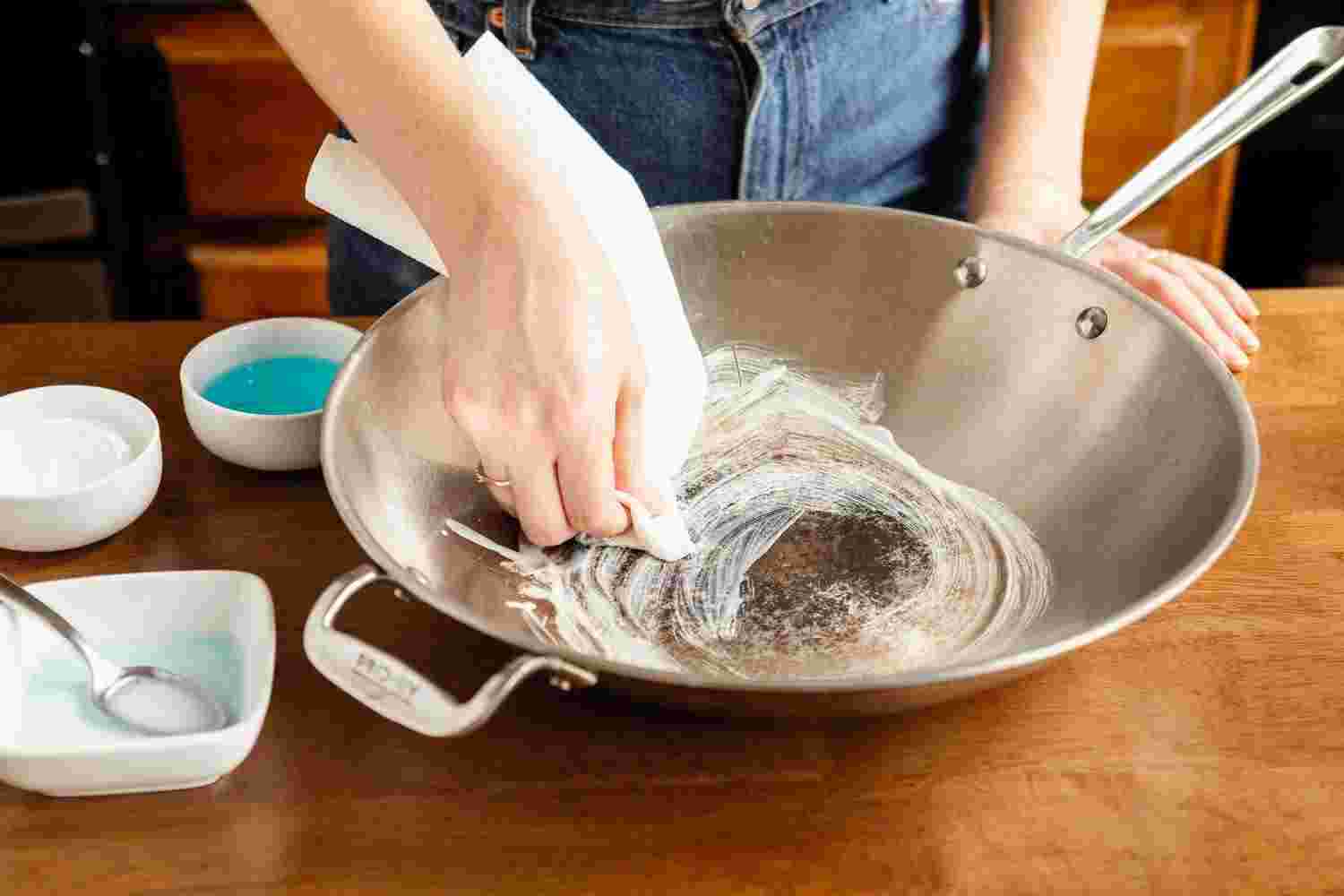
In this step, you will assess whether your pan requires stripping or if a thorough scrubbing will suffice. Combine coarse salt with oil and vigorously scrub away any rust spots or carbon buildup until no more can be removed. Applying gentle heat to the pan may aid in loosening burnt food residue.
Are there layers of seasoning flaking off the pan? Do you notice rough, blackened patches that are stubborn to remove? Attempt boiling water in the pan; if the carbonized food still refuses to let go, it may be necessary to strip the pan.
If you have successfully eliminated the rust or crud and the seasoning remains intact without flaking down to the bare metal, you can proceed to step 5 and season the pan again without stripping it.
2. Soak in Vinegar
The most effective method to remove seasoning from a pan is to soak it in an acidic solution. You can easily create this solution at home by mixing equal parts vinegar and water. Fill a basin or sink with the vinegar-water mixture and submerge the pan in it. Alternatively, if you only wish to strip the inside of the pan and not the exterior, you can place the pan on the stove and fill it with the solution.
If your pan is on the stove, bring it to a boil and allow it to simmer for 10 minutes. The heat will expedite the process. Afterward, do not discard the water; let it sit.
3. Wait
Allow the pan to sit in the vinegar solution for a duration of 4-8 hours. Periodically, use a wooden spatula to scrape off the seasoning and assess its progress. However, the longer you allow the pan to sit, the more effectively the acid will remove the polymerized oil. Personally, I prefer leaving the pan in the solution overnight.
4. Scrub the Seasoning Off
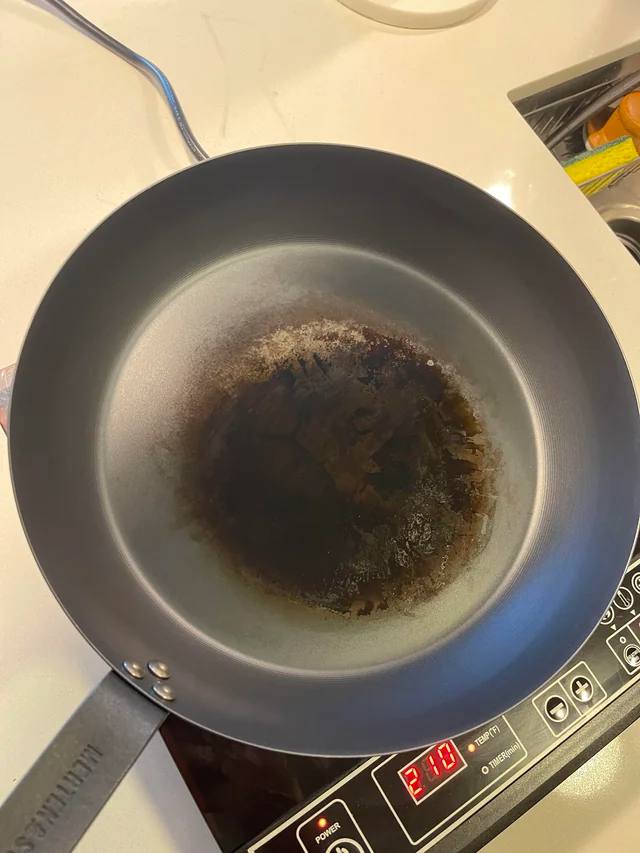
Once the pan has soaked in the solution for a sufficient amount of time, the seasoning should easily scrape off. Use a scouring pad to thoroughly wash the pan and remove any layers of blackened oil. Ensure you are meticulous in this process, as any remaining spots of seasoning on the surface will create an uneven cooking surface and may trap food particles. Do not hesitate to use soap if necessary.
5. Dry and Season the Pan
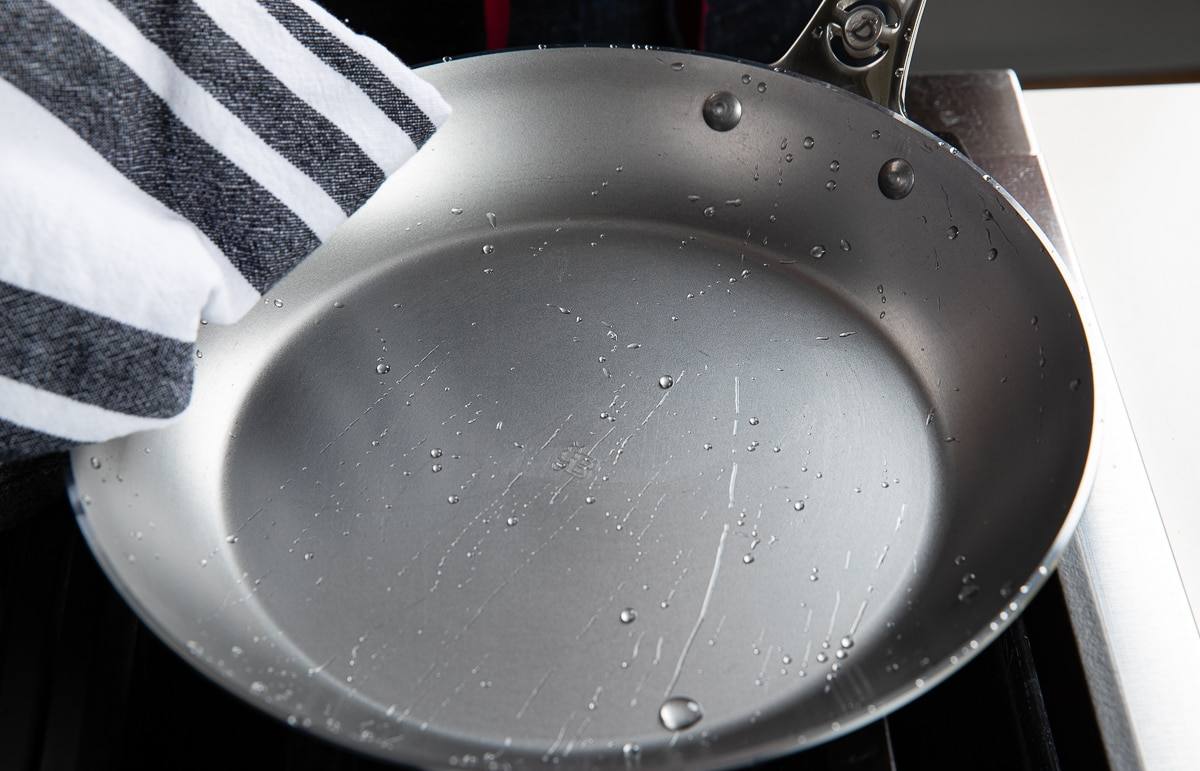
After thoroughly cleaning and removing any residue from the pan, it is crucial to dry and season it properly to prevent rust. To begin, place the pan on the stovetop and set the heat to its lowest setting. Allow the gentle heat to dry off any remaining moisture from the pan. Once the pan is completely dry, remove it from the heat source. 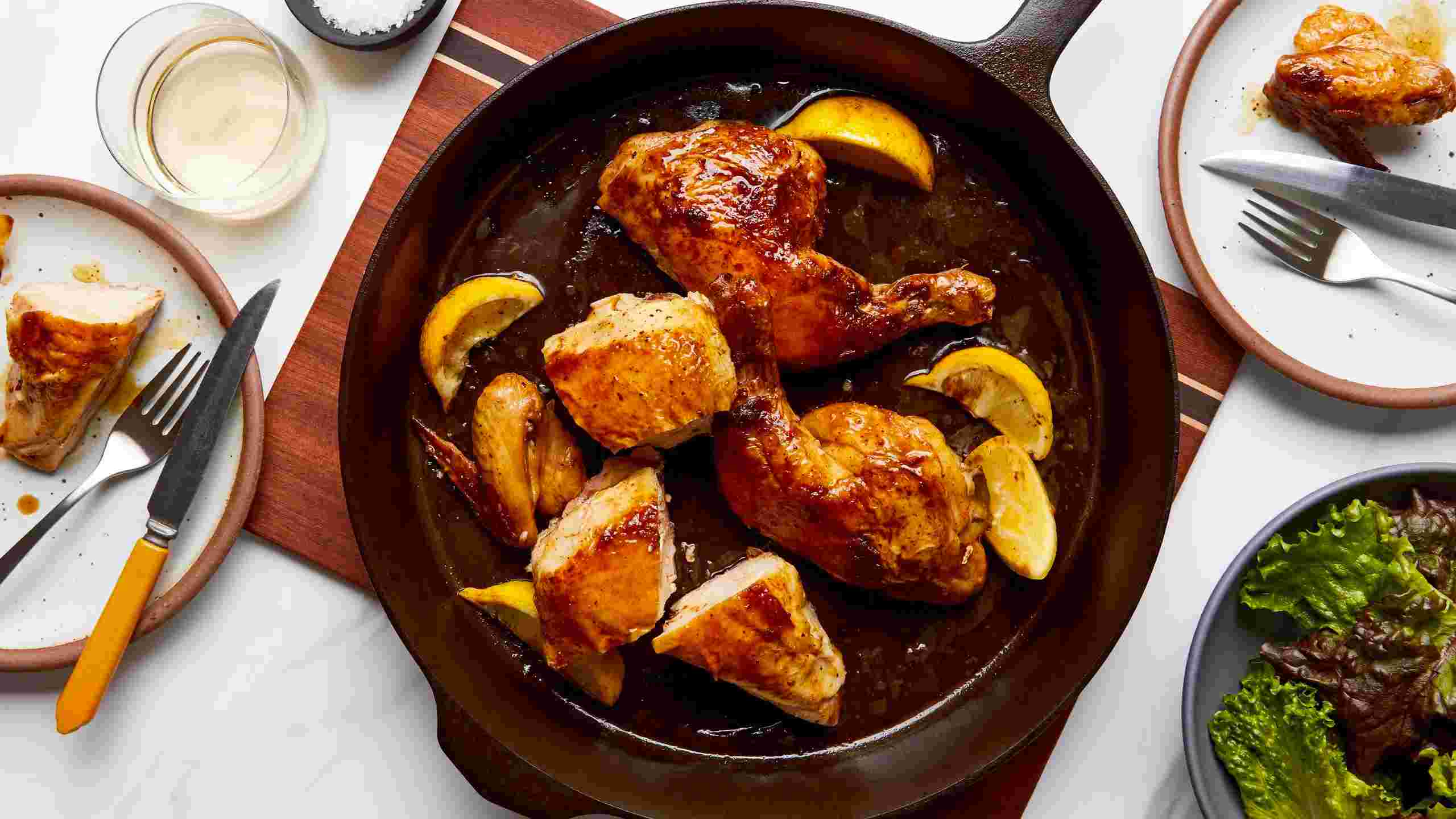
While the pan is still warm, but not hot, evenly distribute a small amount (just a drop or two) of neutral oil across its surface. Be sure to wipe off any excess oil vigorously. Next, return the pan to the stovetop and heat it for several minutes until it undergoes a color transformation, becoming darker, and stops emitting smoke.
For a more comprehensive step-by-step guide on how to season a carbon steel pan, we recommend referring to our detailed tutorial.
Alternate Methods
The vinegar method, although effective, can be time-consuming as it may take overnight to remove the seasoning. While there are other methods available, none of them provide shortcuts. The layers of polymerized oil are tightly bonded to the metal of the pan, making it difficult to remove. Therefore, it is advisable not to rush into a full reseasoning project if you need to use the pan for dinner that night.
.jpg)
If you search online, you will come across various ideas for stripping the seasoning off carbon steel pans. However, some of these methods may not be as safe as others. They include placing the pan in the oven during a self-cleaning cycle (only if the pan has an oven-safe handle), letting the pan sit covered in a lye or acid-based cleaner like Bar Keeper's Friend for several hours (ensuring the cleanser doesn't dry out by placing the pan in a plastic bag), attaching a scouring sponge to a handheld drill and scrubbing the seasoning off, or using an electrolysis tank for badly rusted pans.
However, as you can see from the photos, the vinegar method is not only simple and relatively safe, but it also works exceptionally well. Additionally, in many cases, you may not need to completely strip the pan to fix rough spots in the seasoning.
How Do You Fix Sticky Spots on a Carbon Steel Pan?
The reddish-brown gummy spots found on a carbon steel pan are a result of oil that hasn't fully polymerized. To rectify this issue, use a tough scouring pad along with a mixture of oil and salt or baking soda and water to scrub the spots. To prevent the occurrence of sticky spots in the future, it is advisable to reduce the amount of oil used during the seasoning process to an extremely thin layer that is barely visible.
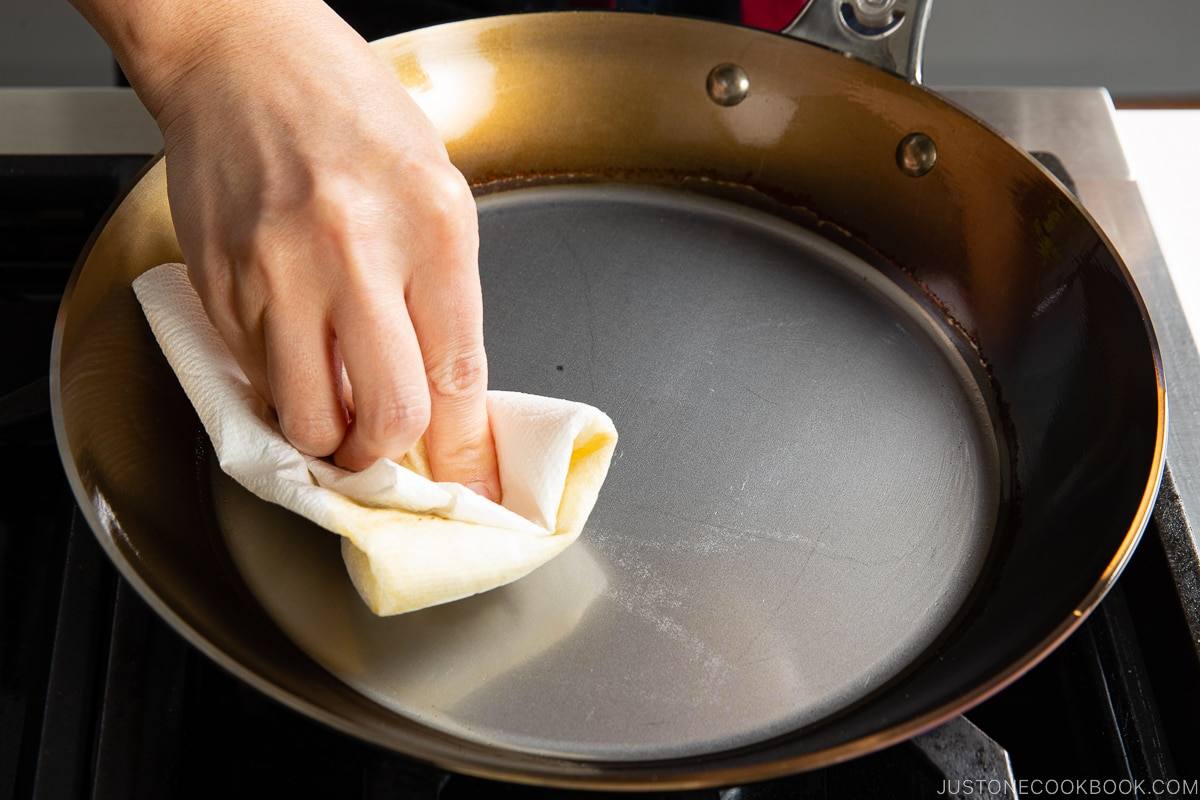
When seasoning a carbon steel pan, it is important to apply just the right amount of oil. If the pan appears glossy after oil application, it indicates an excess amount of oil. To rectify this, continue wiping the pan with a dry paper towel until the oil is barely noticeable. This practice not only prevents sticky spots but also significantly reduces the amount of smoke generated during seasoning.
In case the pan remains slightly sticky after seasoning, you can try heating it further to ensure complete polymerization of the remaining oil.
Lastly, an essential tip to remember is to allow the pan to cool down after drying it on the stove before applying oil. Drying the pan on a warm stove and subsequently applying a layer of oil is beneficial as it safeguards the pan against moisture and rust. However, if oil is applied while the pan is still hot, it may dry and become gummy without reaching the required temperature for polymerization and contributing to the seasoning. (I personally made this mistake for an extended period of time!).
What If the Seasoning is Flaking?
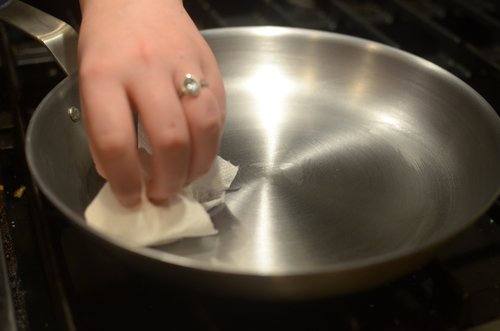
If the seasoning on your carbon steel pan is peeling, you can effectively clean it by scrubbing it with a mixture of salt and oil or by using cast iron soap and a mildly abrasive pad. This method will eliminate any carbon buildup and remove any weak or compromised seasoning that may flake off. Once this is done, you have the option to either fully strip the pan or apply new seasoning to the bare spots. In most instances, seasoning the pan a few times in the usual manner will help restore a smooth and even surface.
In Sum
I have not come across any studies on this matter, but based on my personal experience, the seasoning on carbon steel tends to be more delicate compared to cast iron. It is more prone to flaking, which might make you consider starting the seasoning process from scratch. However, I suggest trying a thorough cleaning and seasoning first. If that doesn't yield satisfactory results, the process of stripping and re-seasoning carbon steel can be quite fulfilling.